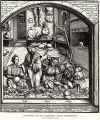Blacksmith's Forge Bellows
[Home] [Back
To The Forge Design] [Blowers,
Bellows, Firepots, & Hearths] [Forge
Bellows] [Chimneys]
[Steel Hoods] [Side
Blast Forge Tuyeres] [Tools
Racks & Storage] [Styles
Of Forges] [Planning
Layout of Hearth]
[Steel
Side-draft Forge and Hood Plans] [Brake
Drum Forges] [Costs
To Build]
UPDATE September 16th, 2019. Under construction.
 Medieval & renaissance era woodcuts and manuscript illustrations of
blacksmiths at work, often show a 'pair of bellows' supplying air to each fire
in the blacksmith's hearth. Some woodcuts showing both bellows each having its
own separate nozzle or tuyere inserted beneath the fire.
Medieval & renaissance era woodcuts and manuscript illustrations of
blacksmiths at work, often show a 'pair of bellows' supplying air to each fire
in the blacksmith's hearth. Some woodcuts showing both bellows each having its
own separate nozzle or tuyere inserted beneath the fire.
A 'pair of bellows' consists of 2 single stage (single acting) bellows
mounted side by side to supply air to the fire, and the bellows are mounted
together so as to allow both bellows to be operated with a single lever. One
bellows ingesting fresh air while its partner is exhaling air into the
blacksmith's fire.
A rocker shaft or pole mounted between the bellows allows the pivoting action
that lifts one bellows while lowering the other. The rocker shaft is mounted
loosely at each of its ends so that it may rotate freely within its bearings.
The operating lever is fastened securely to the rocker shaft. In many
illustrations the operating lever is long enough to be within reach of the
blacksmith while he is standing beside his forge hearth. There are also some
illustrations and woodcuts showing the operating lever to be pulled by
apprentices or helpers that are not near the forge hearth, but most
illustrations show a long lever handle within reach of the blacksmith near the
forge.
A cross arm is fastened securely to the rocker shaft so that each of its ends
is located above the rear of each bellows. If the operating lever is placed
within reach of the blacksmith near the fire as found most often in old
woodcuts, then the other end of the operating lever will often be fastened to
the far end of the cross arm also.
The rocker shaft is mounted loosely at its ends so that it
may rotate freely within its bearings. And as the smith raises and lowers the
operating lever, the ends of the cross arm will in turn, move up and down,
raising one bellows while lowering the other.
Page updated
September 29, 2019
This page is in the early stages of construction and may have
a large number of errors.

Page created March 5th, 2005.
 Medieval & renaissance era woodcuts and manuscript illustrations of
blacksmiths at work, often show a 'pair of bellows' supplying air to each fire
in the blacksmith's hearth. Some woodcuts showing both bellows each having its
own separate nozzle or tuyere inserted beneath the fire.
Medieval & renaissance era woodcuts and manuscript illustrations of
blacksmiths at work, often show a 'pair of bellows' supplying air to each fire
in the blacksmith's hearth. Some woodcuts showing both bellows each having its
own separate nozzle or tuyere inserted beneath the fire.